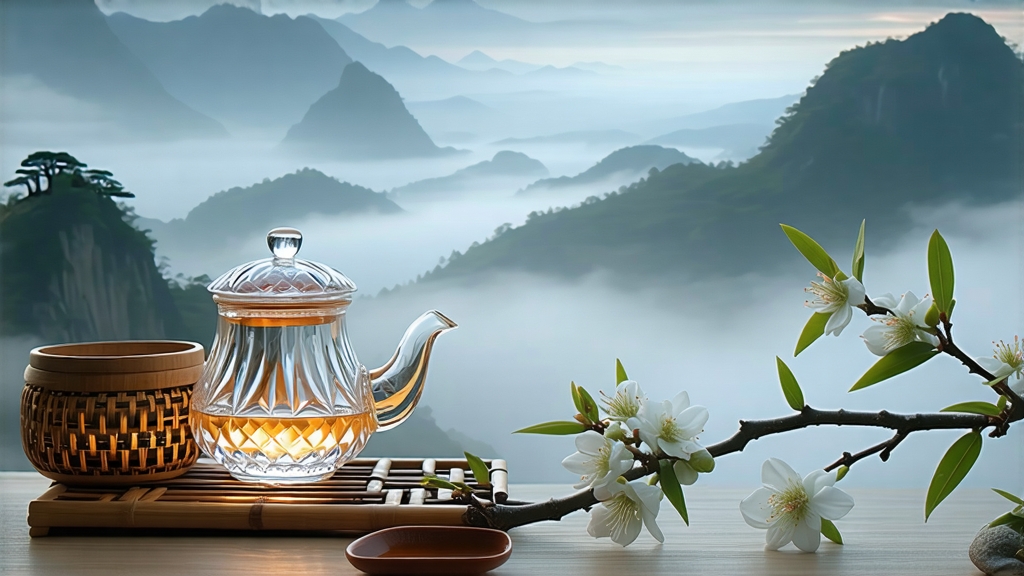
If green tea is the youthful vigor of Chinese tea culture and pu-erh its venerable sage, then white tea—especially the pristine Silver Needle (Bai Hao Yin Zhen)—is the quiet poet who arrives at dawn, speaks in hushed couplets, and vanishes before the sun grows loud. Grown in the coastal mountains of northern Fujian, Silver Needle is the most aristocratic expression of the white tea family, prized for a flavor that is almost an absence: no green bite, no roasted bass note, only a translucent sweetness that lingers like the memory of rain on marble.
History: From Imperial Tribute to Global Muse
The first written record of “white tea” appears in Song-dynasty treatises (960-1279), yet those cakes of compressed silver-down buds were whisked like matcha rather than steeped. The loose-leaf Silver Needle we recognize today took shape during the mid-Qing, when improved roadways allowed Fuding and Zhenghe farmers to wither and dry their spring buds without charcoal roasting, preserving the living enzymes. By 1796 the tea entered the imperial tribute list; legend claims the Daoguang Emperor preferred it diluted to the color of “a late winter moon,” a descriptor still quoted by cupping masters. Export began in 1891 through Fuzhou’s treaty port, and in 1915 Silver Needle won a gold medal at the Panama-Pacific Exposition, sealing its global reputation.
Terroir: Two Counties, One Downy Bud
Authentic Silver Needle is harvested only in Fuding and neighboring Zhenghe, where red-yellow lateritic soil, 1,200 mm annual rainfall, and subtropical fog create a diurnal swing of 10 °C. The cultivars are equally specific: Fuding Da Bai (Big White) and Zhenghe Da Bai, bushes whose spring buds can reach 3 cm, sheathed in such dense trichomes that they look dipped in icing sugar. Attempts to transplant these clones to Yunnan or India yield larger crops but thinner aroma, proving that the cultivar and microclimate are inseparable halves of the same poem.
Harvest Calendar: The Silent Countdown
Plucking begins when the air temperature stabilizes at 15–18 °C, usually between mid-March and early April. Only the unopened bud—no leaf, no stem—is nipped with fingernails (metal shears bruise the cells). Experienced pickers finish before 9 a.m. while dew still guards the bud from oxidation. A full kilogram of finished Silver Needle requires roughly 30,000 buds, all picked within a seven-day window; after that, the bud elongates, the down thins, and the raw material slips below grade.
Craft: The Art of Letting Go
White tea’s minimalism is deceptive; the fewer the steps, the more lethal the mistakes. Once in the factory, the buds are spread on bamboo trays 1.5 cm thick and left to wither for 36–48 hours at 22 °C and 65 % relative humidity. No pan-firing, no rolling—only the whisper of moving air. Master withers adjust the stack every two hours, feeling for the subtle transition from turgid to leathery. When the bud’s moisture drops to 10 %, a final 20-minute bake at 50 °C halts enzymatic activity without caramelizing sugars. The result is a needle that snaps cleanly, revealing an ivory cross-section flecked with microscopic hairs—the signature “silver” that will later suspend in the liquor like dust motes in a sunbeam.
Grades & Styles: A Microcosm Within One Bud
Although China’s national standard lists only two grades—Special Grade and First Grade—connoisseurs recognize three micro-styles. “North-River Needle” (Fuding) gives a bright, orchid-sweet cup; “South-River Needle” (Zhenghe) carries deeper malt and dried-fig notes due to slightly higher oxidation. A third, experimental “Moonlight Needle,” withered entirely at night under LED fans, offers a cooler, marine salinity sought by boutique cafés in Copenhagen. All, however, must pass the same test: when dropped into a porcelain gaiwan, the bud stands on its base for three seconds before toppling—a sign of proper moisture gradient.
Chemistry: Elegance in Numbers
Silver Needle contains the highest ratio of theanine to polyphenols among all teas—often